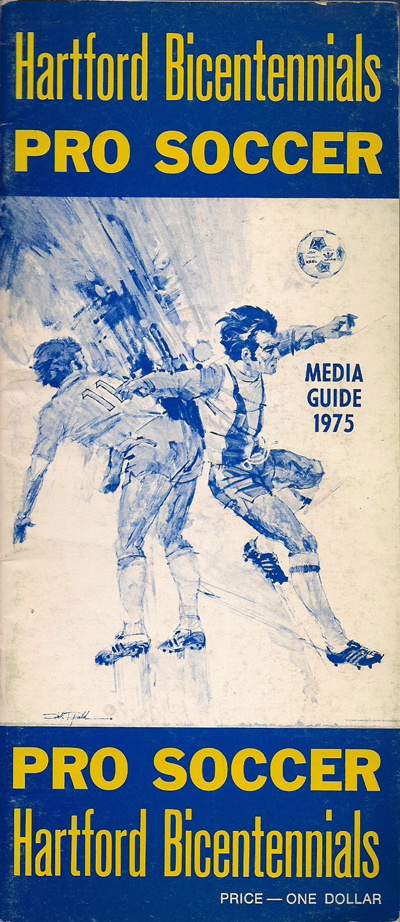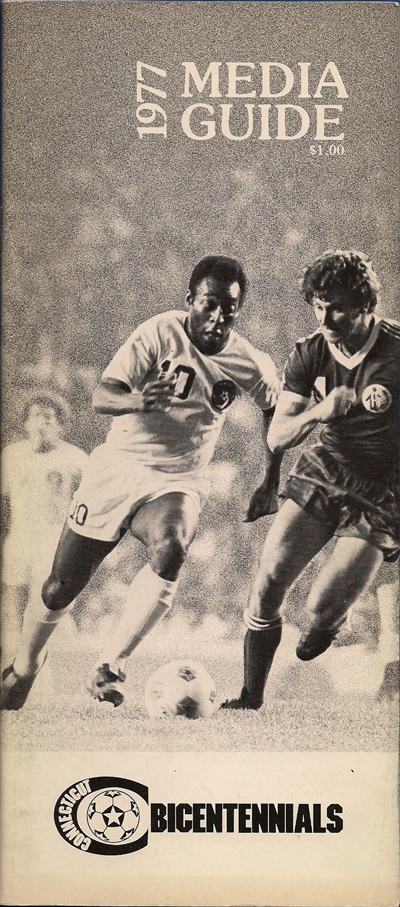North American Soccer League (1975-1977)
Tombstone
Born: January 14, 1975 – NASL expansion franchise1Kohlinsky, Bohdan. “Hartford Gets NASL Franchise; To Start in April”. The Courant (Hartford, CT). January 15, 1975
Moved: September 1977 (Oakland Stompers)
First Game: April 25, 1975 (L 4-0 @ Miami Toros)
Last Game: August 7, 1977 (L 2-1 vs. Chicago Sting)
Soccer Bowl Championships: None
Stadia
1975-1976: Dillon Stadium (14,000)21975 North American Soccer League Media Guide
1977: The Yale Bowl (70,000)31977 North American Soccer League Guide
Branding
Team Colors:
Ownership
Owner: Robert Darling
Background
The North American Soccer League (NASL) awarded an expansion franchise to Hartford, Connecticut in late 1974 to begin play in the spring of 1975. During the same expansion round, the NASL created the Chicago Sting, Portland Timbers and Tampa Bay Rowdies franchises, which all became iconic teams in the early history of American pro soccer, fondly recalled by many middle-aged soccer fans today. The Hartford Bicentennials did not join them in that club.
The Bi’s ramped up for the 1975 campaign by raiding the roster and front office of the minor league Rhode Island Oceaneers, defending champions of the lower division American Soccer League (ASL). Hartford signed the Oceaneers’ star 21-year old American goalkeeper Arnie Mausser and also lured away Head Coach Manny Schellscheidt and General Manager Mike Bosson.
Head-to-Head in Hartford
Meanwhile the Bicentennials faced local competition from an ASL franchise in their own city – the Connecticut Yankees who already played in Dillon Stadium. When the ASL and NASL released their schedules in early 1975, there were five dates when the rival clubs had both scheduled home games at Dillon. The resulting glut of pro soccer helped to depress attendance in one of the NASL’s smallest markets. The Bi’s averaged only 3,720 fans for eleven home matches. The team’s minor league approach also left the team uncompetitive on the field. Hartford finished the 1975 season with a 6-16 record, tied for worst in the 20-team NASL.
In 1976, Yankees owner Bob Kratzer moved his ASL club to West Haven, alleviating the scheduling logjam at Dillon Stadium. The 1976 Bicentennials were a reasonably competitive .500 team (12-12). But after two seasons in Hartford the Bicentennials soured on Dillon Stadium, where the club averaged fewer than 4,000 fans per game. By comparison, the NASL’s top draws in cities such as Minneapolis, Portland and Seattle all claimed average crowds in excess of 20,000 during the 1976 season.
Move To The Yale Bowl
In 1977, the Bi’s moved 45 miles down Interstate 91 to New Haven’s 70,000-seat Yale Bowl. The club dropped “Hartford” from their name and adopted the “Connecticut Bicentennials” moniker for the 1977 campaign.
Like many NASL clubs of the era, the Bi’s drew their best gate of the 1977 season when the Brazilian superstar Pele and his New York Cosmos came to town. A club record 17,302 fans showed for the home opener on May 8th. The teams treated the throng to a superb match. The Bi’s rallied from a 2-0 deficit in the final eight minutes to tie the contest, only to lose when Keith Eddy of the Cosmos beat Bi’s keeper Gene DuChateau on a penalty kick with less than two minutes remaining.
After the novelty of Pele’s appearance wore off, Bi’s attendance returned to Hartford-esque levels. Among other factors, owner Robert Darling cited the lack of professional grade lighting at the Yale Bowl, which limited the Bi’s to afternoon and early evening start times. The team’s lackluster talent couldn’t have helped – the Bi’s regressed to a league-worst 7-19 record. The Bi’s attendance was also brought up the rear in the 18-team NASL at fewer than 4,000 customers per match.
Demise & Aftermath
In September 1977, Bi’s owner Bob Darling sold the team to Milan Mandaric, owner of the NASL’s San Jose Earthquakes, for an undisclosed amount. As part of the transaction, Mandaric divested himself of the Earthquakes and moved the former Bi’s franchise – now renamed the Oakland Stompers – just across the Bay at the Oakland Coliseum.
After one season at the Oakland Coliseum, Mandaric sold the team to Edmonton Oilers hockey team owner Peter Pocklington, who moved the franchise to Alberta where it played four more seasons as the Edmonton Drillers before folding in 1982.
Voices
“The Bicentennials were owned by Bob Darling who I knew from Simsbury. Our kids played soccer together. Darling was a nice guy, but kind of naïve. He was very wealthy and he wanted to own a soccer team.
Darling picked that Bicentennials name in 1975 because 1976 was going to be the American bicentennial, right? I said: ‘What about after 1976? What are we gonna be then? The 19-seventy-seven-tennials?’ It was a terrible name. Not much meaning to it and too long to fit in the headlines. So we became known as the ‘Bi’s’ in the papers, which I didn’t care for because it sounded like the team was bi-sexual.”
-Rudi Schiffer, General Manager 1976-1977 (2012 FWiL Interview)
“We used to cut the grass so high in the Yale Bowl that the other teams had trouble playing. It was like two or three inches high.
One time we were playing the Los Angeles Aztecs in New Haven and they had a bunch of foreign stars including Georgie Best. They came into town early in the week and were staying in a motel about ten miles away. Our Head Coach Malcolm Musgrove says ‘Rudi, go over there and see what they’re doing.’ I went over and sat next to the pool for most of the week and they were just drinking themselves to death and sneaking out every night, you know?
I came back and told Musgrove ‘Coach, we’ll kill these guys! They won’t be able to make the second half. They’re all drunk.’ They beat us 5-3. Musgrove said ‘You should have found out what kind of whiskey they were drinking.’
-Rudi Schiffer
Bicentennials Shop
Editor's Pick
Rock n' Roll Soccer
The Short Life and Fast Times of the North American Soccer League
by Ian Plenderleith
The North American Soccer League – at its peak in the late 1970s – presented soccer as performance, played by men with a bent for flair, hair and glamour. More than just Pelé and the New York Cosmos, it lured the biggest names of the world game like Johan Cruyff, Franz Beckenbauer, Eusebio, Gerd Müller and George Best to play the sport as it was meant to be played-without inhibition, to please the fans.
The first complete look at the ambitious, star-studded NASL, Rock ‘n’ Roll Soccer reveals how this precursor to modern soccer laid the foundations for the sport’s tremendous popularity in America today.
When you make a purchase through an affiliate link like this one, Fun While It Lasted earns a commission at no additional cost to you. Thanks for your support!
In Memoriam
Bicentennials owner Robert E. Darling passed away in October 2009 at the age of 72.
Downloads
2012 FWiL Interview with former Bicentennials General Manager Rudi Schiffer
Links
###




